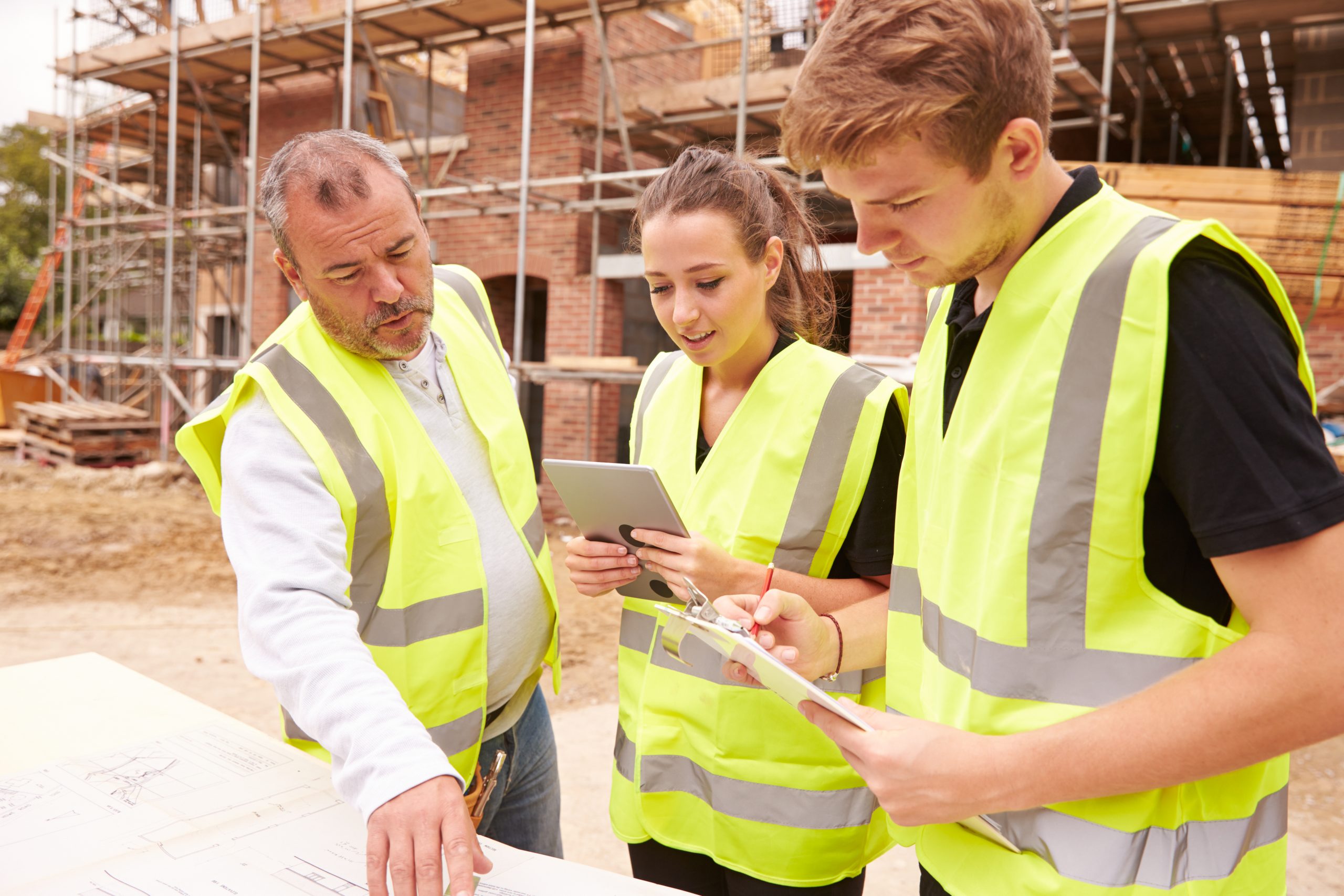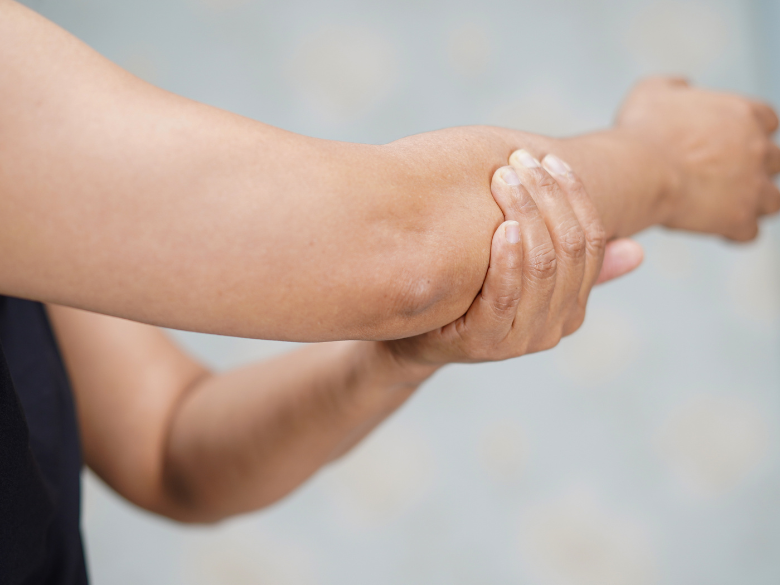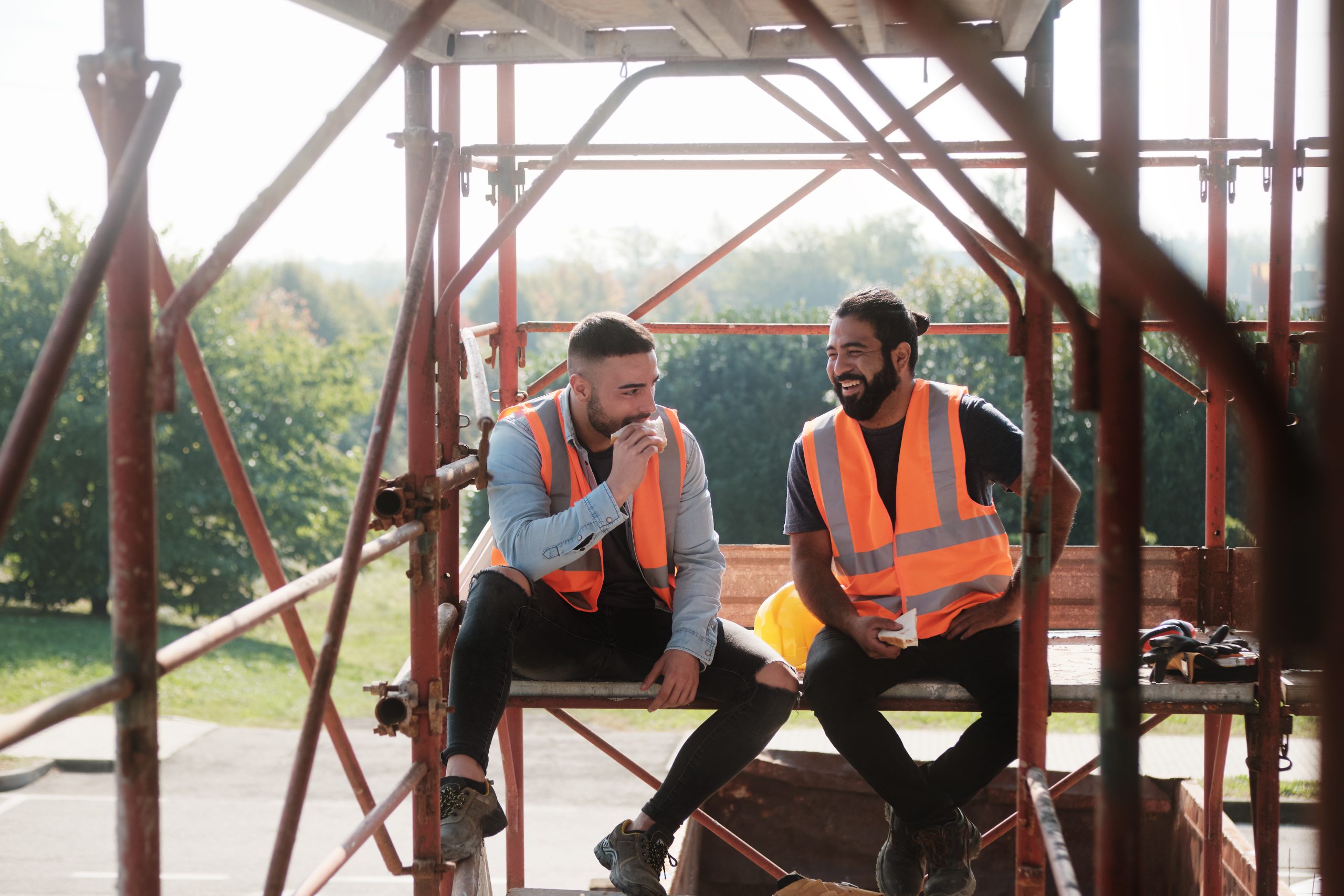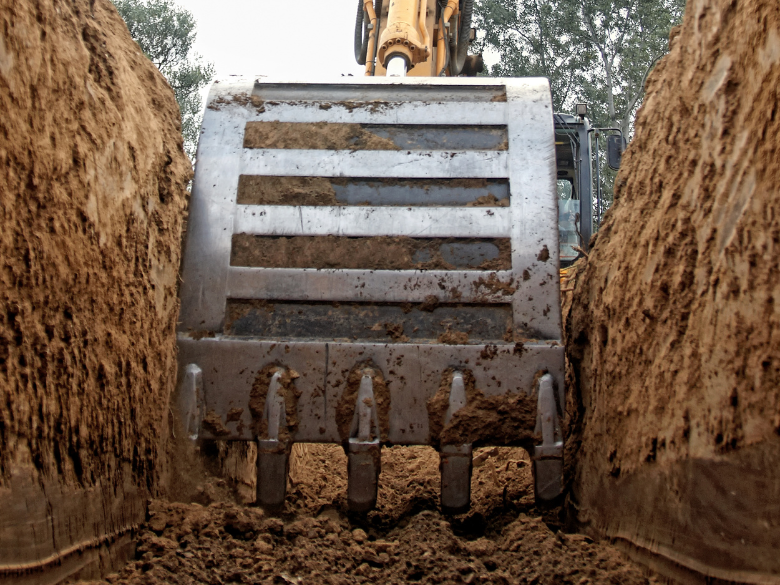
In light of the recent changes to Australia’s industrial manslaughter laws, we sat down with Glenn, one of our HazardCo Health and Safety (H&S) experts to break down what these laws mean for building companies and tradies.

Q: Glenn, what exactly is industrial manslaughter?
Glenn: Industrial manslaughter is a big deal because it means that if a business owner or someone in charge of a worksite doesn’t take safety seriously, and it leads to a worker’s death, they could be held legally responsible. It’s about accountability. If you knew—or should’ve known—that what you were doing (or not doing) could seriously harm someone, and it ends up causing a death, then we’re talking about industrial manslaughter.
Q: So what’s new with these laws? How are they different from before?
Glenn: The big change here is that industrial manslaughter is now a criminal charge—meaning individuals can face serious charges, and potentially be convicted and face prison time if found guilty. It’s a clear message that safety is non-negotiable. With South Australia and NSW putting in place industrial manslaughter laws this year, and Tasmania pending, they will soon be nationwide.
Q: Who does this law apply to? Is it just for business owners?
Glenn: While business owners are definitely in the spotlight, this law can apply to anyone who has a duty of care on a worksite. So if you’re in a position where you’re responsible for other people’s safety, and your negligence causes a fatality, you could be held accountable. It’s not just about the big bosses; anyone with responsibility for safety needs to be on their game.
Q: Can you give us some examples, Glenn, of how this duty of care might play out on a construction site?
Glenn: Absolutely. In construction, there are plenty of scenarios where this duty of care comes into play. For example, if a site supervisor gives wrong information, tools, or instructions, and a worker is killed, that site supervisor could be facing a charge of industrial manslaughter. It’s the same for contractors—say one builds faulty foundations, and someone ends up getting hurt or worse, that contractor could also be held responsible. And it doesn’t stop there; the PCBU (Person Conducting a Business or Undertaking) might also be on the hook if they didn’t have solid processes in place to ensure the build was up to standard.
Q: What constitutes industrial manslaughter, Glenn? What are the criteria for being charged?
Glenn: To be charged with industrial manslaughter, a few key things need to line up.
First, you have to be a PCBU or an officer of the PCBU.
Second, you must have engaged the individual to work on your site.
Third, you need to be aware of the safety risks they were exposed to.
Fourth, you didn’t do anything about those known risks—whether it’s changing, communicating, or documenting them.
And finally, a fatality has to occur as a result of those risks that you were aware of and failed to address. The main thing that really seals the deal here is what’s called “gross negligence.” Legally, it means that if you have a duty of care, know about a risk, and don’t take action, it becomes much easier to prove negligence. It’s not just about being aware of the risk; it’s about failing to act on it.
Q: This all sounds pretty serious, Glenn. Should businesses be worried?
Glenn: It’s serious, but there’s no need to panic if you’re doing the right thing. The key takeaway is that these laws are here to protect workers. If you’re following safety protocols, keeping your worksite safe, and not cutting corners, then you’re on the right track. The law is only a threat to those who ignore their responsibilities. It’s about doing what’s right, not just for the law, but for the safety of everyone on site.
Q: What steps can businesses take to avoid being charged with industrial manslaughter?
Glenn: There are five simple steps that can really help you stay on the right side of the law—and more importantly, keep everyone safe.
If you have any questions get in touch with the HazardCo team today
You’re probably across the recent engineered stone ban, but did you know SafeWork Australia has just come out with new rules to further protect workers from crystalline silica found in other building materials? These new rules begin on 1st September this year and apply to all states except Victoria whose rules are already in place.
Crystalline Silica Substances (CSS) include stuff like sand, stone, concrete, and mortar that contain at least 1% crystalline silica. When you cut, crush, drill, polish, saw or grind these materials, they release tiny dust particles called respirable crystalline silica (RCS). These particles are so small they can get deep into your lungs, which can lead to serious health issues, like silicosis—a lung disease.
If silica dust is generated, assess if the work is high-risk. Document this using the handy Form in the HazardCo Hub, and if you determine the work is not high risk, you must explain why. If you’re unsure, assume it is high-risk. When assessing if processing CSS is high risk, consider these factors:
Eliminate or minimise the risks from processing the CSS as much as possible and use at least one of the following measures during the processing:
If workers are still at risk of being exposed to silica dust after you’ve put one or more of the above controls in place they need to be provided with respiratory protective equipment (RPE) and wear the respiratory protective equipment while the work is carried out.
Avoid high-risk tasks when possible. If unavoidable, create a silica risk control plan outlining tasks, risks, and controls. This plan must be developed with workers, shared with them before starting work, and regularly reviewed for effectiveness.
What needs to be in a silica risk control plan?
Keep it simple and easy to understand—no need for lengthy explanations.
We suggest using the SWMS tool in the HazardCo App if the processing creates a contaminated atmosphere or involves high-risk construction work. Just ensure all the Silica Control Plan requirements are covered.
Ensure that any worker involved in or at risk of RCS exposure due to high-risk CSS processing receives crystalline silica training. This training must be nationally accredited or approved by the WHS regulator and should cover health risks and the correct use of control measures.
Conduct air monitoring if you’re unsure whether silica levels exceed the Workplace Exposure Standard (WES) or need to assess if there are health risks from RCS processes. Hire a certified expert like an occupational hygienist, to perform the monitoring and ensure it meets standards. If levels exceed limits, report it to the Regulator within 14 days. Keep records for 30 years and make them available to affected workers.
Provide health monitoring for workers at significant risk from ongoing silica exposure, including those near high-risk processing. Keep records for 30 years and give a copy to the worker.
Regularly review safety measures, especially after workplace changes.
If you need guidance, reach out to our advisory team at 1800 954 702 for assistance.
HazardCo understands that on-site first aid is about more than just sending someone on a course every few years. As an employer or principal contractor on-site, you have a legal and moral obligation to make sure your team has access to first aid equipment and facilities, as well as access to trained first aiders.
To determine the necessary level for your workplace, assess the site by considering:
Don’t forget to involve your workers in the process and if you are working with multiple trades, or are the principal contractor, you should share information and work together cooperatively.
Having a first aid kit on a construction site is essential to quickly address injuries and medical emergencies. Great kits can be sourced from many places – a basic kit should include equipment t to tend to:
Basic first aid kits are not always enough given the nature of construction work and increased risk of eye injury, cuts, falls etc, so you’ll need to consider what other equipment to add e.g. eye pads, eyewash, additional dressings and bandages.
Include your team and see if they think your first aid kit is sufficient for the site hazards and team size… and make sure they know who the trained first aider is and where the first aid kit is kept! It helps if your first aid kit is clearly labeled and is made from a material that can protect the contents from dust, moisture and contamination.
Lastly, assign someone to be in charge of replenishing the kit. Make sure this happens regularly and keep a list of what’s supposed to be in the kit to make topping it up easier. At the same time, check training is up to date for your first aiders, and if your team size has changed, whether you still have enough team members trained in first aid.
Keeping first aid up to date is the right thing to do by your team, so make sure you’ve got things covered and that you’re all prepared if any sort of injury takes place.
If you have any questions please contact the HazardCo team today.
Did you know that if you’re carrying out renovation work the same risks apply as a new build? Whether you’re carrying out extensions, renovating, flood remedial work, large landscaping jobs or you’re engaging contractors for the work, HazardCo have you covered.
You will firstly need to think about how you will manage health and safety on-site and how you will communicate this with other people involved in the build, such as the homeowner, or other contractors on-site. This will ensure that everyone is on top of the site hazards and practicing good health and safety during your build.
A HazardCo Project is ordered for each significant job, such as a new house build or large renovation. They contain site-specific resources for that job, including:
Have a read of the following 5 areas, if you meet these requirements a Project could be needed.
Even if none or only some of the above 5 areas apply, the HazardCo app and hub can still be used effectively outside of ordering a project. So keep reading.
We recommend that you use the HazardCo App and Hub to manage your on-site health and safety. Here are our tips to get the most out of the HazardCo system:
Lastly, sometimes renovation projects can be unique and you may still feel unsure about whether you should order a project or how the HazardCo system can help you to manage Health and Safety effectively. So give us a call and we can chat about your upcoming works and how HazardCo may work best for you. So don’t be shy – get in touch with us and we’ll help you make your site a safer one.
Maintaining clean amenities is just as important as keeping your site nice and tidy. Employers have a duty to provide adequate workplace amenities/facilities, including toilets, that are in good working order, clean, safe and accessible.
Not meeting these requirements can lead to a risk of infection, disease, psychosocial harm or infringements/enforcement from the Regulator. Regulators often actively check work sites to ensure workers have access to clean and safe amenities.
When planning amenities on your site, consult with your workers to understand what will be needed. Getting them involved will give you the opportunity to provide information, training and instruction on things like keeping the site amenities clean and reporting any problems.
More often than not portable toilets are not maintained in a safe or hygienic way. Employers must make sure that toilets are cleaned and serviced regularly, and, just like plant and other on-site equipment, safe to use and operated the way it was designed to be used.
Toilets should also:
Don’t forget, the toilet should be easy to access in all weather conditions and be placed on stable, flat ground to ensure it can operate properly.
Clean drinking water must be supplied to workers by installing site water taps as early as possible. If the mains have not been connected, provide workers with drinking water in containers, coolers or flasks.
Workers should have a clean and weatherproof area for meals and rest breaks. Using the garage or a similar sheltered area can be used and be set up as soon as possible. If they aren’t available on-site, workers should be given enough time on their breaks to access eating facilities off-site. Facilities should also include:
In the early stages of construction a worker can use their vehicle for shelter until a suitable area becomes available.
As always, if you have any questions please give our team a call on 1800 954 702 or contact us.
It’s important for young people starting out in construction to understand how to stay safe at work. Young workers lack experience and might not know about all the hazards yet, which could put them in danger of getting hurt. Sometimes young people might feel like they have to impress others, or they might think they’re better at the job than they actually are, they may also forget about safety rules or be afraid to speak up if something seems unsafe. Because of this young workers have additional needs and should be supervised when working on-site.
Positive safety culture onsite comes from the top down, supervisors should be actively modeling and training young workers about safety rules, make sure they have the right gear, and encourage them to speak up if they see any problems.
There are some jobs that young workers shouldn’t do because they might not have enough experience or strength yet. Supervisors need to make sure young workers can handle their tasks and keep an eye on them until they are sure they are able to do the work safely. Young workers also need to think about their own safety, listen to instructions and follow safety rules.
When everyone works together to stay safe, it helps make sure everyone goes home safely at the end of the day.
Now, let’s delve deeper into some specific measures that can be taken to ensure the safety and well-being of young workers in the construction industry:
Employing young workers in the construction industry has benefits for the young person, the company and for the industry as a whole as the next generation of builders learn and grow into future roles. By prioritising safety and investing in the well-being of young workers, employers can create a culture of safety that benefits everyone involved. Together, we can build a safer and more secure future for the next generation of construction workers.
If you have any questions, get in touch with the HazardCo team today
Tools, vehicles, and heavy equipment all create vibrations that can affect your body. This is a normal part of any tradie’s day, whether you’re picking up power tools or jumping in the ute. It’s so common that many don’t realise the potential harm these vibrations can cause. However, it’s something you should start thinking about and being aware of.
How are workers harmed?
Vibrations are a natural part of working on any construction site but they do create a risk to you and your workers. Repeatedly using vibrating hand and power tools, or being around vibrating vehicles and machines can lead to serious and lasting harm to your blood vessels, nerves, and joints. Many of the most commonly used items give off some form of vibration. Here are the most common ways tradies are exposed to vibrations:
While these are the most common forms of exposure, the below should also be considered as they increase the risk of overexposure to vibrations:
Early warning signs
We understand that for many tradies, working with vibrations is a natural and unavoidable part of the job. With that in mind, there are a few warning signs and symptoms of overexposure to keep an eye out for:
If you are continually exposed to vibrations especially in your hands and arms you can develop hand-arm vibration syndrome (HAVS) or carpal tunnel syndrome (CTS).
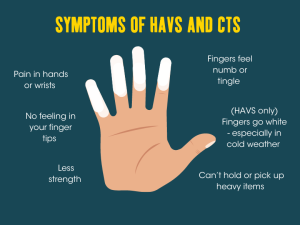
What you can do to manage risk
It is up to everyone on-site to look out for each other. Consultation with your team should take place to make sure an environment can be created where excessive exposure to vibrations are eliminated or minimised.
Below are simple yet effective ways to either eliminate or minimise the effects.
Above all else, be aware that vibrations can be extremely harmful, especially when you’re exposed for lengthy periods of time.
Your best tool for minimising the effects of vibrations is to start a conversation with your boss, or your team, and put steps in place to look out for each other and your equipment.
If you have any questions please reach out the the HazardCo team
Updated on 26 August 2024
On 1st July 2024 an engineered stone ban will take effect in all states and territories. The ban prohibits the use, supply, manufacture, processing or installation of engineered stone benchtops, slabs or panels.
Further information is yet to come on:
Until now, the focus has been on engineered stone, however crystalline silica can be found in many other building materials. It has just been announced from 1st September 2024 changes to the crystalline silica regulations will be made to further protect workers.
This includes working out if the processing of the crystalline silica substance is high risk and putting in place additional control measures if it is. Read our summary of the Crystalline Silica rules.
A new Code of Practice will be released in all states to reflect these changes. During its development, Safe Work Australia will provide guidance to help businesses and workers understand and comply with the new regulations.
Engineered stone is an artificial product that:
If you need to repair, remove, dispose of or make any minor modifications after 1st July 2024, you will need to notify your state regulator first. Notification forms will be available from your state regulator along with any other specific information such as timeframes and re-notification requirements.
VIC – A licence is no longer needed to work with engineered stone from 1st July 2024 and no notification will be required to work with already installed stone.
NSW, SA, WA, TAS, QLD – Notification forms will be available from your state regulator before 1st July 2024 and you will need to submit the form before starting any work.
NT – Written notification will be required every 12 months. The form will be ready before 1st July 2024.
ACT – Notification is required from 1st November 2024 and you will only need to notify once.
Remember, before starting any of the work you must have control measures in place to minimise the dust and you must wear respiratory protection.
Creating a SWMS in the HazardCo App can help you with selecting the right controls for the task such as using water suppression or on-tool dust extraction, and a minimum P2 dust mask or respirator.
There are plenty of silica-free options out there to suit every budget such as timber, stainless steel, and laminate options have come a long way, such as these Contact Sheet options from Laminex.
https://www.safeworkaustralia.gov.au/esban
https://www.safeworkaustralia.gov.au/esban/faq
https://www.worksafe.vic.gov.au/frequently-asked-questions-engineered-stone-ban
Information correct as of: 24th June 2024
Respiratory Protective Equipment (RPE) is essential gear for protecting you from inhaling hazardous substances. In this blog, we’ll explore the important role of RPE, whether you are dealing with airborne contaminants like asbestos, fumes, dust, or working in a confined space, RPE is an essential personal protective equipment (PPE) that makes sure you can breathe safely. Join us as we deep dive into the different types of RPE, their applications, and how they can protect you from potential health risks.
Before you even get started with RPE, make sure you have other practical control measures in place first; such as local exhaust ventilation or direct dust-extracted tools with a vacuum catchment to get rid of the majority of contaminants in the air. You should also be keeping an eye on your team’s health and workplace conditions to ensure that, over time, they aren’t being made sick or getting injured by their work.
Remember, there is no such thing as a healthy dust, even if you are outside!
We’ve gone ahead and put together a quick guide of factors to consider when providing your workers with RPE.
Disposable respirators are good for short term or one-off use and when you have existing controls in place to give you extra protection. When using a disposable respirator you need to make sure a seal has been created to protect you from harmful particles such as dust, fumes and fibres.
Respirators use replaceable filters to remove contaminants to clean the air for the wearer. They come in half-face and full-face versions. The cartridge filters are specific to certain types of contaminants, ask your manufacturer exactly which cartridge you should be using for the respirator you have and the contaminants you will be facing.
Remember if you have stubble or any facial hair you may not be getting the seal and the protection you think you are! So if you love your bread as much as your lungs read on to find out what you can do
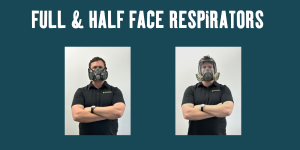
Powered air purifying respirators (PAPRs) consist of headgear and fan assembly that take contaminated air, filters it, and then delivers the clean air to the user. These are also known as positive pressure systems. These not only keep you nice and cool, but offer the highest protection there is for people who have facial hair. Something to note with these is that the visors and headset can be impact rated if you need it, and don’t fog up because of the airflow.
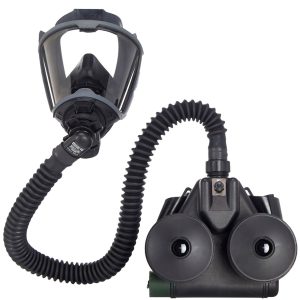
Supplied air respirators provide a supply of clean air to the wearer from a source such as an air compressor or cylinder. It’s important to note that the air supply needs to be checked regularly to make sure that it is safe to use – just think about what you see coming out of your air compressor when you release the valve under the air tank! The user must also be trained in how to use the system.
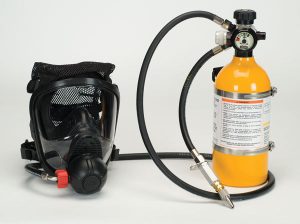
It’s important for your workers to be trained in using and maintaining their RPE. They should visually check their RPE for signs of damage before each use to identify any issues, including whether it needs to be cleaned or decontaminated.
Make sure your team keep their RPE on while working in the hazardous area. Removing it for even a short period of time is a risk to their health.
Did you know that they come in different sizes? One size does not fit all!
If your workers are using RPE then make sure they are fit tested, this way you will know who needs what size, otherwise it may not work and give the protection your workers need.
The manufacturer of the RPE can tell you who can do this testing.
There are two checks which you need to do each time you use and RPE:
1 – check for damage visually to the sealing surfaces and straps
2 – check the valves are functioning correctly like WorkSafe images below
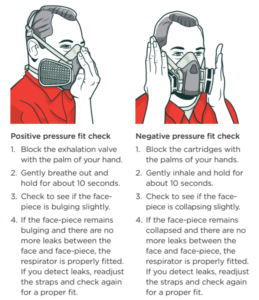
Image Source: Worksafe New Zealand
Keep in mind that if your worker’s safety glasses fog up while they are wearing a half-face respirator, this is a sign that there is a leak at the top of the respirator which means they are not getting full protection.
When your workers are wearing respiratory protective equipment at work, they must be clean shaven to ensure it is forming a seal and protecting them from breathing in hazardous materials. Even a small amount of stubble can prevent RPE from sealing correctly which means your workers will still be inhaling harmful materials which may cause health concerns. A clean shave goes hand in hand with the correct RPE for the job.
It’s your legal responsibility to monitor your workers’ health. Make sure that you are completing regular Site Reviews on the HazardCo App, as this will help you to identify potential hazards and put effective plans in place. Your HazardCo Advisory Team is available throughout the day to guide you through this – call 1800 954 702 to talk it over.
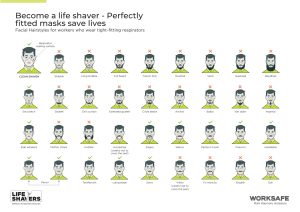
Image source WorkSafe
How to reduce psychosocial hazards on your work site
The workplace hazards that create risks of harm to psychological (mental) health are known as psychosocial hazards. These hazards, when excessive or prolonged, can cause serious harm. It can have a significant impact on workers, their families and business.
Construction workers are six times more likely to die from suicide than an accident at work. Every year 190 Australians working in the construction industry take their own lives; this means we lose a construction worker every second day to suicide. Young construction workers are two times more likely to take their own lives than other young workers.
Psychosocial hazards can come from:
What are some of the work related factors that affect a mentally healthy work site?
Whose responsibility is it to manage psychosocial hazards?
Workplaces have a legal responsibly to manage risks to mental health and well-being like they do any other health and safety risk.
Knowing where to start can feel overwhelming but getting started doesn’t have to be. Take action to improve the mental health of your team today.
Tips to help build a mentally healthy work site
Create a more positive and supportive work site
Establish awareness and support for workers experiencing mental health issues
Celebrate workers and their efforts
Take steps to improve role clarity and job satisfaction
If you have challenges on your work site related to psychosocial hazards, give us a call for advice. As a HazardCo member you can have a chat with the experienced health and safety Advisory Team for no extra cost.

